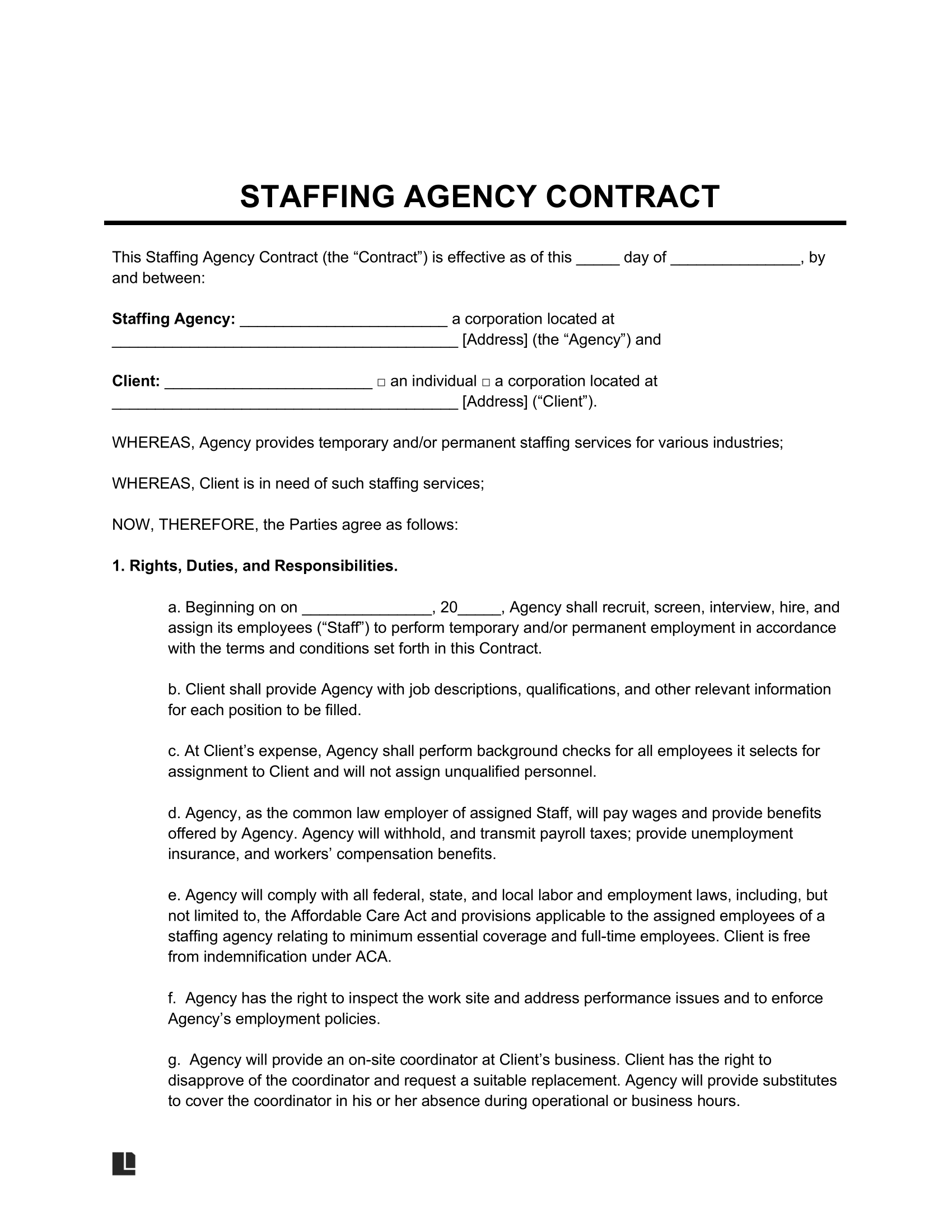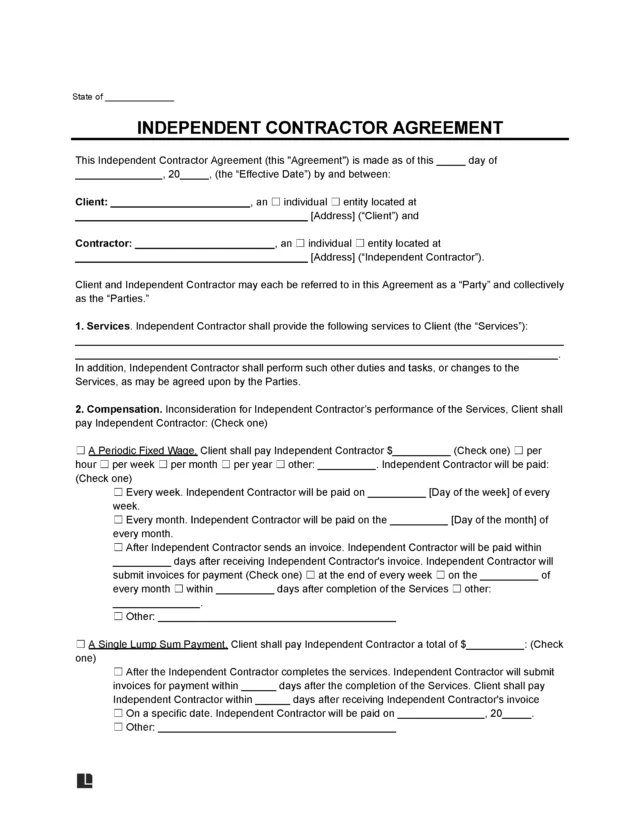What Is a Staffing Agency Contract?
A staffing agency contract outlines a relationship between a staffing agency and a company to recruit and staff. The agreement clearly describes the services that will be provided, when those services will begin, and the cost of the work.
It also incorporates several legal protections to mitigate risks by offering these services. Utilizing a staffing agency contract template is a fast and easy way to ensure you place a protective, transparent, and legally accurate contract.
Sample Staffing Agency Contract
Below is our free staffing agency contract template, available in PDF and Word for you to download:

When to Use a Staffing Agency Contract
A staffing agency contract is essential whenever a company engages your services for staffing solutions. This contract covers vital employment conditions for full-time, part-time, or temporary employees to prevent future legal complexities.
As a staffing agency, your responsibilities encompass recruiting, screening, interviewing, and hiring employees on behalf of the company.
While such arrangements are typically short-term, it’s important to note that some staffing agencies can also handle hiring for permanent positions, depending on the mutually agreed goals. Therefore, entering into a working relationship with an organization like this necessitates using a comprehensive staffing agency contract.
What To Include in a Staffing Agency Contract
The staffing agency contract should include the following:
- The name and address of both parties
- The date the agreement will go into effect
- The type of relationship
- The terms and conditions of the process
- The payment terms for those hired
- The payment term for the agency from the client
- A definition of how the contract will be terminated
- The signatures of representatives from each company
How to Write a Staffing Agency Contract
Here is a step-by-step guide on how to write a staffing agency contract:
Step 1 – Introduction
In the introduction section of the staffing agency contract, provide a brief overview of the purpose and intent of the agreement. Identify the parties involved, including the full legal names and addresses of the staffing agency and the client.
Step 2 – Effective Date
Specify the effective date of the contract, the date on which the contractual obligations between the staffing agency and the client are enacted. This is important for determining the timeline and duration of the agreement.
Step 3 – Rights, Duties, and Responsibilities
Delineate the specific services the staffing agency provides, such as recruiting, advertising, screening, and interviewing. Outline the terms and conditions that govern these arrangements.
Include requirements for the client to provide job descriptions, applicant qualifications, and the client’s responsibility for covering background check costs and any necessary employee evaluation forms.
Step 4 – Payment Procedures
Clearly explain how payments will be handled for newly hired individuals. Specify whether payments will be facilitated through the agency or the client, particularly for permanent positions.
Clearly state the party responsible for collecting and remitting federal, state, and local labor and employment taxes. Address any other legal obligations related to employee management.
Step 5 – On-Site Coordinator
If the staffing agency provides an on-site coordinator, clearly outline their duties and responsibilities within the contract.
Step 6 – Compensation Terms
In the compensation section, provide a thorough breakdown of the costs and payment structure for the services offered.
Include any applicable markup fees, fixed hourly rates, compensation terms for permanent positions, retainer fees, and billing rates for additional services, and specify the agreed-upon date for fee payment.
Step 7 – Contract Termination
Outline the procedures and conditions under which either party may terminate the agreement. Specify the notice period required for termination and any applicable penalties or fees.
Additionally, address any specific circumstances that warrant immediate termination, such as breach of contract or non-compliance with legal or ethical standards.
Step 8 – Relationship and Confidentiality
This section helps to establish the nature of the relationship between the staffing agency and the client. Specify that the staffing agency is an independent contractor and not an employee or partner of the client.
Additionally, include provisions regarding the confidentiality of sensitive information shared during the engagement.
Address the responsibility of both parties to maintain the confidentiality of proprietary information, trade secrets, client lists, and any other confidential or sensitive data.
Step 9 – Indemnification and Liability
Include a section that defines each party’s responsibilities and liabilities in case of any legal claims, disputes, or damages arising from the staffing services. This helps establish a clear understanding of the risks involved and the steps to be taken in such situations.
Step 10 – Governing Law and Jurisdiction
Specify the governing law under which the contract will be interpreted and any specific jurisdiction where disputes or legal matters will be addressed. This adds clarity to the legal framework surrounding the agreement.
Step 11 – Amendments and Modifications
Outline the process for amending or modifying the contract. Specify that any changes to the agreement must be made in writing and signed by authorized representatives of the staffing agency and the client.
State that verbal agreements or informal discussions do not constitute valid modifications to the contract.
Step 12 – Severability
State that if any provision of the agreement is found invalid, illegal, or unenforceable, it will not affect the validity or enforceability of the remaining provisions.
This ensures that if one part of the contract is deemed unenforceable, the rest remains intact. Including a severability clause provides protection and allows the contract to continue to govern the relationship between the staffing agency and the client.
Step 13 – Signatures
Conclude the contract with spaces for the authorized staffing agency representatives and the client to sign and date the agreement. Signatures indicate the formal acceptance and execution of the contract.
Make sure to include printed names and titles of the signatories, as well as the date of signing.




